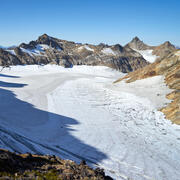The Search for One of North America’s Rarest Birds
The McKay's Bunting - Alaska's only endemic landbird species
Q&A: The Role of USGS Ecosystems Science in Alaska
Assisting Executive and Department of Interior Secretarial orders and priorities
Anchorage Bike to Work Day - May 16, 2025
The USGS Alaska Science Center will host a station along the Lanie Fleischer Chester Creek Trail
Environmental Occurrence of Avian Influenza Virus Relative to Bait Trapping of Waterfowl
Study finds that bait trapping was associated with localized increases in avian influenza virus
Anchor River at Anchor Point
USGS has 24 river webcams in AK. Here is one river's data, photos, and timelapse video.
Alaska Science Center
The mission of the Alaska Science Center is to provide objective and timely data, information, and research findings about the earth and its flora and fauna to Federal, State, and local resource managers and the public to support sound decisions regarding natural resources, natural hazards, and ecosystems in Alaska and circumpolar regions. We have offices in Anchorage, Juneau, and Fairbanks.
In the Spotlight

Critical Minerals in Ores (CMiO) database
Critical minerals are commodities essential to modern industrial and strategic technologies and are highly vulnerable to supply chain disruption. The CMiO database contains geochemical data for more than 20,000 samples from more than 100 deposit types comprising 10 deposit environments.





